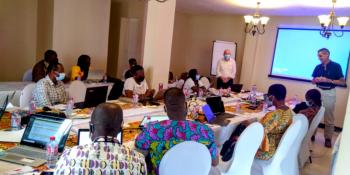CCAFS science strengthens investments in climate services for agriculture

Summary
The research was implemented in collaboration with the International Research Institute for Climate and Society (IRI).
Climate services are highly practical tools, improving farmer decision-making and strengthening their ability to cope with increased climate variability and extreme weather events. By providing climate advisories and weather forecasts, these services enhance farmers’ capacity to deal with risk. Through research and stakeholder engagement, CCAFS informed and shaped investments into climate services, building the capacity and know-how of agencies and organisations tasked with getting the information out to farmers. These investments, totaling approximately USD 16 million, include:
- USD 10 million investment by the Norwegian Agency for Development Cooperation (Norad) in a multi-sector national implementation project in Tanzania and Malawi, under the UN Global Framework for Climate Services (GFCS)
- World Bank investment in agrometeorological services in Myanmar
- USAID investment in climate-services through a small grants initiative designed by CCAFS
In the GFCS case in Tanzania and Malawi, CCAFS was involved in the planning of how investments were to be used, shaping the initial climate services framework workshop, radio and ICT strategy, as well as the coordinated strategy for building up the capacity of national meteorological services. In Myanmar, CCAFS assisted the World Bank’s design of Hydromet Service Delivery Systems, by informing the choice of project partners and focusing on the need for investment in training and technical support to make the climate information relevant for farmers. With regard to USAID investments, CCAFS scientists at IRI worked closely with USAID to develop a small grants program, to catalyze (cross-)regional efforts to scale up climate services for farmers.
Key facts
- Climate services help farmers cope with climate change, by providing information and advice
- CCAFS has informed approximately USD 16 million in financing, directing them towards investment in climate services
- Products in high demand include forecasts of rainy season onset and end, and warnings of extreme events
Lessons: key elements of success
- Scientific information can be inaccessible to some farmers – care must be taken to ensure the services can reach them
- Indigenous knowledge should be used as an entry point for introducing and complementing scientific forecasting
- Radios are effective means of delivering forecasts, but social networks can spread information where infrastructure is lacking
Further reading
Related research outputs
- Sivakumar MVK, Collins C, Jay A, Hansen J. 2014. Regional priorities for strengthening climate services for farmers in Africa and South Asia. CCAFS Working Paper no. 71. Copenhagen, Denmark: CGIAR Research Program on Climate Change, Agriculture and Food Security (CCAFS).
- Tall A, Hansen J, Jay A, Campbell B, Kinyangi J, Aggarwal PK and Zougmoré R. 2014. Scaling up climate services for farmers: Mission Possible. Learning from good practice in Africa and South Asia. CCAFS Report No. 13. Copenhagen: CGIAR Research Program on Climate Change, Agriculture and Food Security (CCAFS).
- Hansen et al. 2011. Review of seasonal climate forecasting for agriculture in sub-Saharan Africa. Experimental Agriculture 47:205-240.


